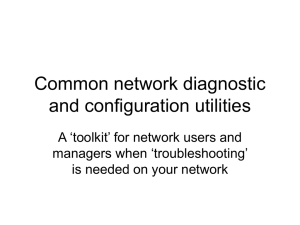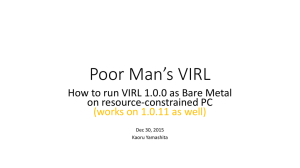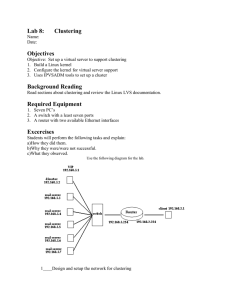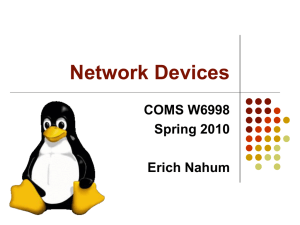A “real” network driver? We want to construct a Linux
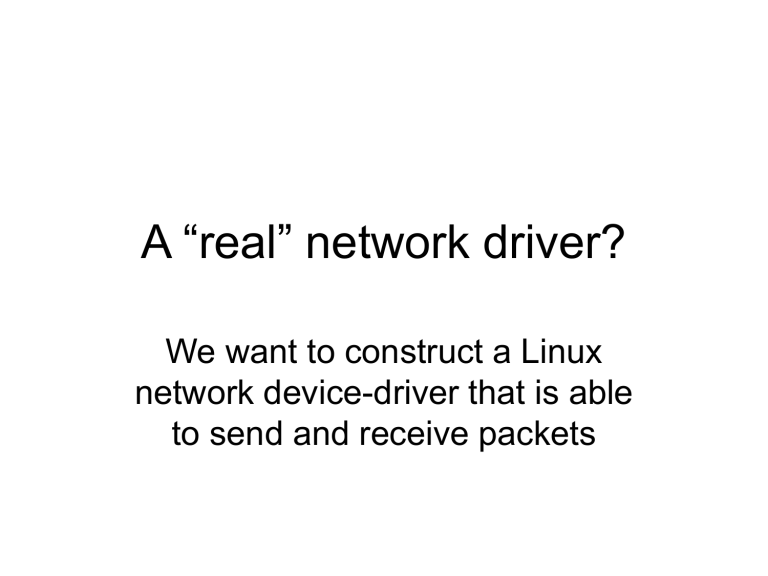
A “real” network driver?
We want to construct a Linux network device-driver that is able to send and receive packets
Our ‘framework.c’ demo
• Earlier in our course we wrote a ‘skeleton’ network device-driver that showed us the minimum elements necessary to interact successfully with the Linux kernel, though it did not program any actual hardware
• Since then we have learned how to write code that does control network hardware, by building ‘character-mode’ Linux drivers
Role of device-drivers
user space kernel space standard runtime libraries
Linux operating system kernel file subsystem networking subsystem application program character device driver network device driver hardware devices
Pedagogy
• Using character-mode device-drivers has advantages for studying how the network controller hardware works -- because we don’t have to worry about interfacing with the Linux kernel’s networking subsystem
• But we don’t end up with a ‘real’ network device-driver until we do create code that can work with that networking subsystem
Source-code layout
netframe.c
#include <linux/module.h>
#include <linux/etherdevice.h>
… typedef struct {
/* driver’s private data */
} MY_DRIVERDATA;
The network driver’s
“payload” functions char modname[ ] = “netframe”; struct net_device *netdev; my_open() my_stop() my_hard_start_xmit() my_isr() my_get_info() Optional pseudo-file (for debugging assistance)
The mandatory moduleadministration functions my_init my_exit
‘minimal’ functionality
• Use the mimimum number of descriptors
• Use simple ‘legacy’ descriptor-formats
• Maintain a minimal set of driver statistics
• Omit flow-control and VLAN tagging
• Omit nonessential interrupt-processing
• Omit use of packet-filtering options
• Omit use of device’s ‘offload’ options
Interactions with the kernel
module_init() calls ‘register_netdev()’ module_exit() calls ‘unregister_netdev()’ open() calls ‘netif_start_queue()’ stop() calls ‘netif_stop_queue()’ hard_start_xmit() calls ‘dev_kfree_skb()’ rx_handler() calls ‘dev_alloc_skb()’ and netif_rx()’
‘mynetdvr.c’
• We can demonstrate the basic transmit and receive functionality of our network driver using a pair of ‘anchor’ machines
• But we have to work around some slight amount of interference with the alreadyinstalled ‘e1000’ network-driver which is supporting our ability to do remote login via the ‘eth0’ device interface
The ‘anchor’ installation-steps
• 1. Bring down the ‘eth1’ interface
$ sudo /sbin/ifconfig eth1 down
• 2. Install our network device-driver
$ /sbin/insmod mynetdvr.ko
• 3. Bring down the ‘eth1’ interface again
$ sudo /sbin/ifconfig eth1 down
• 4. Assign IP-address to the ‘eth2’ interface
$ sudo /sbin/ifconfig eth2 192.168.2.x
Demo #1: ‘ping’
• Suppose you assigned the following pair of IPaddresses to the ‘eth2’ interface on ‘anchor01’ and the ‘anchor02’ machines, respectively: anchor01$ sudo /sbin/ifconfig eth2 192.168.2.101
anchor02$ sudo /sbin/ifconfig eth2 192.168.2.102
• Then try to ‘ ping ’ anchor02 from anchor01: anchor01$ ping 192.168.2.102
Demo #2: client-server
• You can try executing our ‘udpserver’ and
‘udpclient’ application-programs:
– First execute ‘udpserver’ on anchor01 anchor01$ udpserver
Socket has port #32774
– Then execute ‘udpclient’ on anchor02 anchor02$ udpclient 192.168.2.101 32774
Demo #3: ‘nicwatch’
• Remember, you can watch the incoming and outgoing packets on an interface by using our ‘nicwatch’ application: anchor01$ nicwatch eth2 anchor02$ nicwatch eth2
